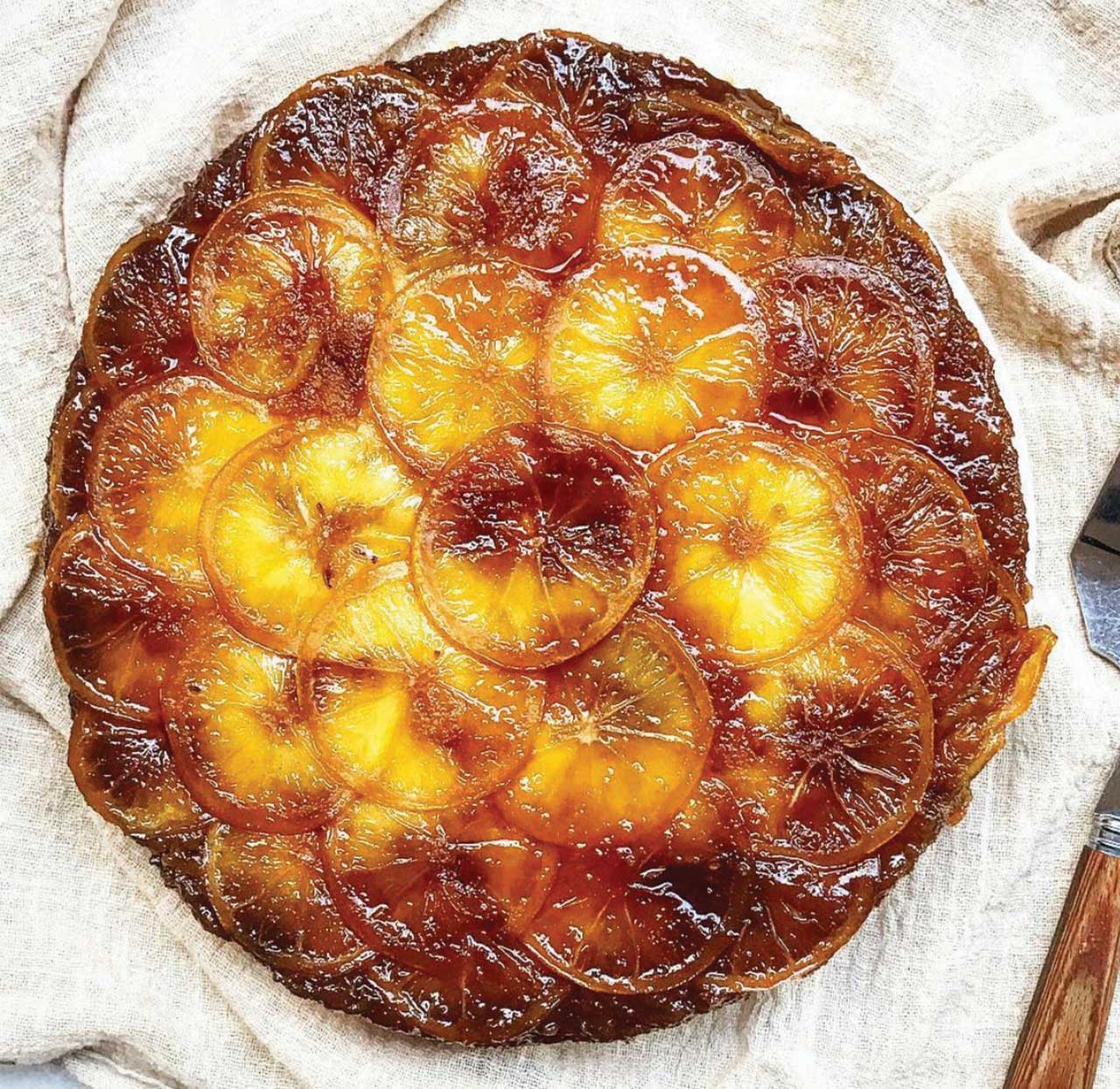Upside-down cake is one of my all-time favorites to bake due to its stunning good looks, its easy-peasy assembly, and its scrumptious caramelized fruit topping. Perhaps the most famous of the upside-down cakes is that of the pineapple variety (and truth be told, I’ve actually never taken a stab at one), but I have made them with bananas, peaches, sour cherries, and plums – to name a few. All are delicious and all basically call for the same easy steps: melt butter and sugar in an oven-proof skillet or cake pan, decoratively place the fruit over the melted butter and sugar, overlapping in a pretty pattern if you are so inclined, cover in a simple cake batter, and bake. Once baked, let the cake rest briefly before flipping it over – the bottom becomes the top and that show-stopping top is nothing short of glorious, what with its softened fruit, sticky, glistening and warm from the caramelized butter and sugar. Yum
Show-stopping yum!
And the cake I am sharing with you here is no different (in its show-stopping gloriousness). Citrus is a perfect fruit for winter baking and in this instance Meyer lemons, skin and all, are sliced razor thin and crown our celebration-worthy cake. Meyer lemons are slightly sweeter than regular lemons and their skin is thinner, making them perfect in this upside-down application. But if you can only find regular lemons, no worries: you can use them, just make sure you slice them paper thin (I recommend a mandolin, if you have one).
The cake here is also flavored with lemon (not just topped with it). The recipe calls for the zest and the juice and a little extract if you’ve got it, or don’t mind purchasing it. The combination of the lemon-y cake with the actual slices of caramelized lemon on top is a winner every time. You can use the Meyer lemon zest and juice for the cake, but if you’d rather use the juice and zest from a regular lemon, that is okay too. The cake is practically a one-bowl situation – you assemble it in the bowl of a stand mixer or in a large mixing bowl if you are using a hand mixer. And you apply the reverse creaming method when doing so, which means you add the dry ingredients and the butter together first and once the butter is coated in flour, you add the wet ingredients. Making a cake this way results in a tight velvety, crumb and allows you to skip the step of whisking your dry ingredients in a separate bowl – meaning there is less clean up (you’re welcome).
Make sure you use a very sharp knife when cutting the cake, so you can easily slice through the lemon skin and serve each slice with a dollop of freshly whipped cream or ice cream, if you know what’s good for you.
For the caramelized Meyer lemon slices
1/4 cup unsalted butter
1/4 teaspoon kosher salt
2/3 cup dark brown sugar
2 Meyer lemons, sliced paper thin, preferably with a mandolin, 1/8-inch or less, seeds removed, and ends discarded
For the cake
1 cup granulated sugar
2 tablespoons lemon zest
1 1/2 cups cake flour
1/2 teaspoon baking soda
1/4 teaspoon baking powder
3/4 teaspoon kosher salt
1/2 cup unsalted butter, softened
1/2 teaspoon lemon extract, optional
1/2 teaspoon pure vanilla extract
2 tablespoons lemon juice
1 large egg, room temperature
1 yolk, room temperature
1 cup buttermilk, room temperature
Preheat the oven to 350°F and assemble the caramelized lemon slices. Melt the butter in a 9-inch cake pan in the oven, watching it closely so it does not burn.
Carefully remove the pan from the oven and sprinkle with the brown sugar and salt. Stir to combine with a fork and evenly spread with a small offset spatula.
Decoratively arrange the lemon slices over the butter and sugar, overlapping them slightly, until the bottom of the pan is covered. You may have a few leftover slices.
To make the cake, place the sugar and zest in the bowl of a stand mixer, fitted with the paddle attachment, and using your fingers, rub the zest into the sugar. Sift the flour, baking soda, baking powder, and salt over the bowl with a medium metal sieve. On low speed, mix to combine. Add the softened butter and mix until all of the butter is coated in flour and resembles coarse meal.
Add the extracts, lemon juice, and then the egg and yolk, one at a time, mixing until combined. Add the buttermilk and increase the speed to medium. Beat until the batter is smooth and glossy, about 30 seconds.
Transfer the batter to the prepared pan, spreading it with a small offset spatula.
Bake for 33-36 minutes, rotating at the halfway point, until a cake tester comes out with a moist crumb or two and the cake is just starting to come away from the sides of the pan. Let sit for 15 minutes, run a paring knife around the edge, and then carefully invert the cake onto a serving platter.
Let cool to room temperature. Slice with a very sharp serrated knife and serve with vanilla ice cream or lightly sweetened whipped cream.
The cake will keep on the counter wrapped in plastic wrap for up to three days, but it is best the day it is made.

Jessie is a baker and cookbook author; you can learn more about her through her website www.jessiesheehanbakes.com.
